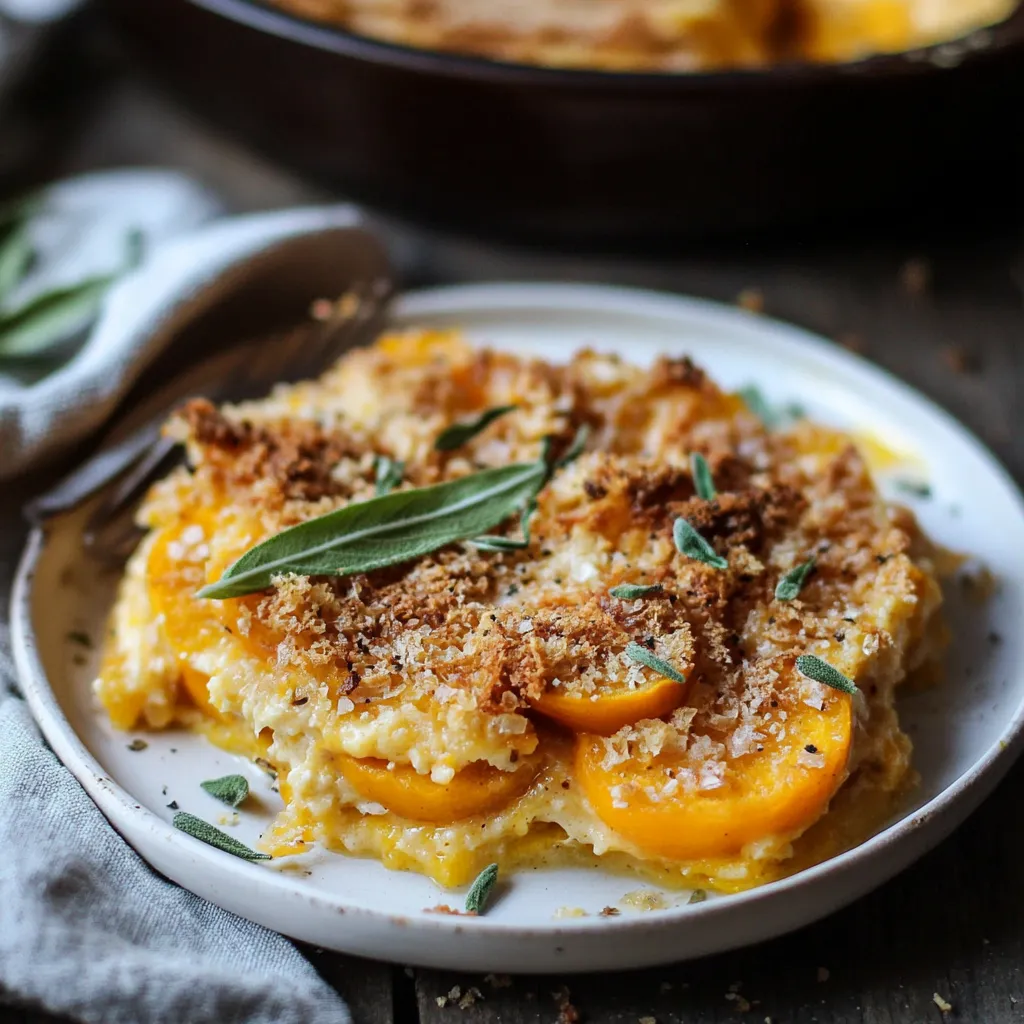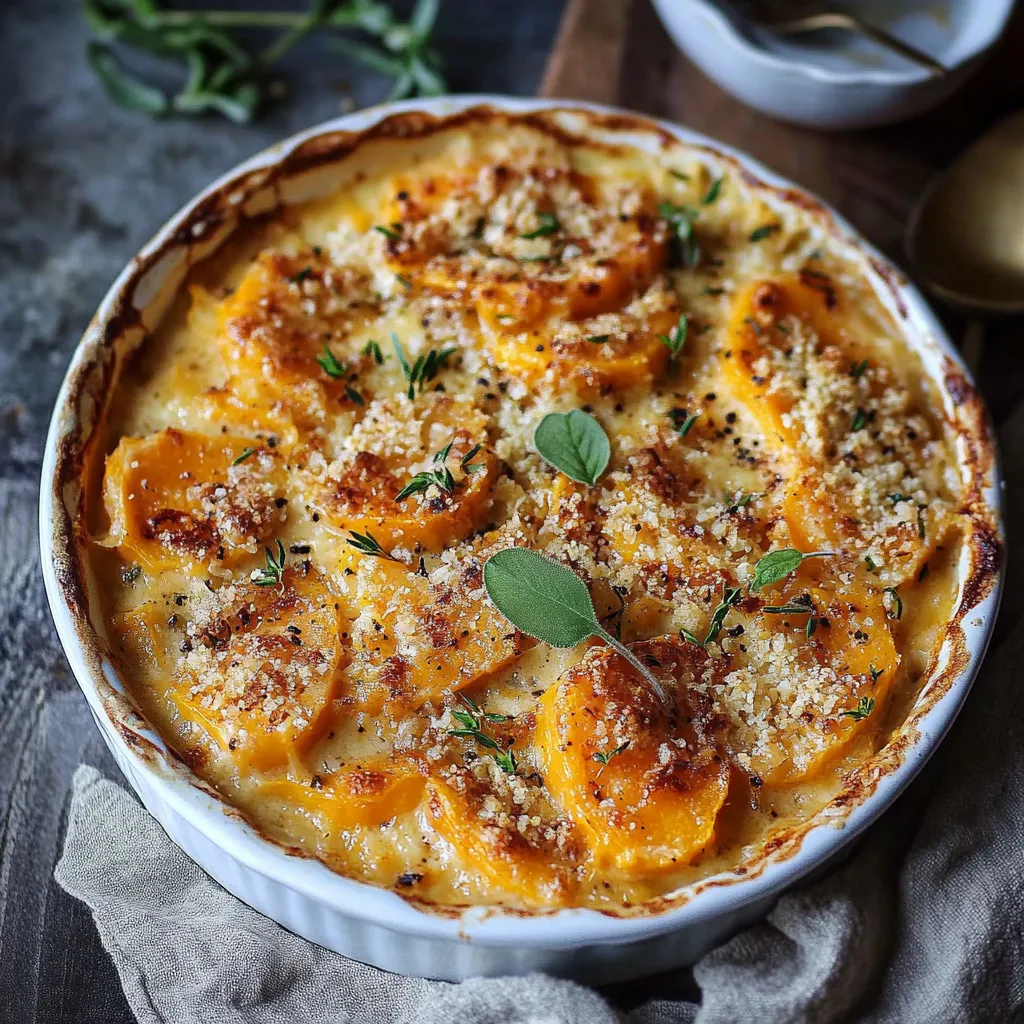 Pin it
Pin it
The velvety, smooth layers of butternut squash paired with softened leeks make this a dish you won't soon forget. This butternut squash gratin turns an ordinary winter veggie into something truly amazing, blending the woodsy taste of fresh sage with the light crispness of toasted walnuts. The way these flavors work together makes this a knockout dish for any get-together, particularly when the weather cools down and we're looking for something hot and filling.
I came across this dish at a cooking class one autumn, and now my family asks for it all the time. The way the squash gets soft but keeps its form, along with the fragrant leeks, creates something that even my veggie-avoiding nephew can't resist.
Key Dish Elements
- Butternut Squash: Go for a squash with an extended, chunky neck for slices that match up well. Find one that's weighty for its size with smooth, dull skin free of marks
- Leeks: Hunt for sturdy leeks with snappy, vivid green tops and white parts at least 4 inches long. New leeks offer a milder, more gentle taste than regular onions
- Sage Leaves: Nothing beats the woody, intense flavor of fresh sage leaves. Grab ones that look silver-green without any black marks
- Heavy Cream: Don't skimp here—full-fat cream gives you the smoothest result. The fat helps keep it from breaking apart while cooking
- Gruyère Cheese: Try to find aged Gruyère with tiny crystals for maximum flavor. Aging brings out those complex, nutty hints
- Walnuts: Pick pale, fresh nuts that don't smell funny. Toast them right before you use them to boost their natural oils
Making Your Tasty Gratin
- Getting Started:
- Set up your oven and get your tools ready. Clean and trim your veggies carefully. Let everything come to room temp before you begin.
- Working With The Squash:
- Take your time peeling the butternut squash so no tough bits remain. Cut circles of the same size so they'll cook evenly and look pretty.
- Cooking The Leeks:
- Slowly cook your cleaned leeks until they're soft and see-through. Throw in your herbs at just the right time to get all their flavor.
- Putting It Together:
- Layer everything carefully, starting with a thin splash of water. Press down gently on each layer so everything cooks at the same rate.
- Finishing Up:
- Top it off with your prettiest squash slices and plenty of cheese and walnuts.
My grandma always told me that making a good gratin was all about taking your time with the layers. She showed me how to place each ingredient just right, like you're creating art. Whenever I smell this dish cooking, I'm right back in her kitchen again.
Great Food Combos
Make this gratin into a full meal by adding a fresh green salad with a light dressing. For bigger occasions, it tastes fantastic with roasted chicken or turkey. And don't forget a glass of chilled white wine to match those creamy, savory flavors.
 Pin it
Pin it
Changing It Up
This easy-to-adjust gratin can fit all sorts of diets and tastes. If you can't do dairy, try coconut cream for richness and a hint of sweetness that works great with the squash. Non-dairy cheeses work well too, especially ones made from nuts like cashews or almonds. Want more texture? Try adding some wild mushrooms between the squash layers, or mix some hemp seeds with the walnuts for extra protein and crunch.
Keeping Leftovers Fresh
When stored right, this dish stays tasty for days after you make it. Let it cool all the way before you put it in a sealed container. The flavors actually mix together better overnight, so it's great to make ahead. When you want to eat it again, let it warm up on the counter first, then heat it slowly in the oven to keep it creamy. A little splash of warm cream before reheating helps bring back that silky texture.
I've learned that taking your time in the kitchen often leads to the best food. The slow building of flavors, careful stacking, and gentle baking turn basic ingredients into something special. This dish shows us that comfort food can be fancy and healthy at the same time, perfect for bringing people together around the table.
Fall Gatherings
This gratin really stands out during fall get-togethers, when the air gets cooler and we start wanting warmer, heartier foods. It's fancy enough for special dinners but still works for everyday family meals. The pretty layers of golden squash make it a showstopper on any table. I've found it goes great with roasted meats, though it's filling enough to be a main dish for vegetarians.
Creating Memories
Through the years, this dish has become part of our family traditions, showing up at holiday meals and special events. Every time I make it, I think about all the memories we've built around this food. My kids now help me layer everything, which is a wonderful way to teach cooking skills and create strong family bonds through food. Just making this gratin together has become almost as meaningful as eating it.
Picking The Best Ingredients
The ideal time to whip up this gratin is during butternut squash season, from early fall through winter. Fresh, in-season squash has a natural sweetness that makes the whole dish better. I've noticed that spending time picking out just the right squash makes a big difference in how it turns out. Look for one that's heavy for its size with dull, tan skin that doesn't have any green stripes or soft spots. Paying attention to these details turns a good dish into an outstanding one.
 Pin it
Pin it
Frequently Asked Questions
- → Can I fix this squash dish before my guests arrive?
- For sure, you can put it all together and keep it in the fridge before cooking, or fully cook it and warm it up at 350°F later. Just let it sit out a bit before heating for best results.
- → How can I make this without dairy products?
- Just swap the heavy cream for coconut milk and grab some vegan parmesan instead of gruyere cheese to make it totally dairy-free.
- → What's the easiest way to cut the butternut squash?
- Grab a sharp knife and peel the squash first. Then cut it into thin rounds about 1/8-inch thick. When you hit the seeds, just scoop them out and keep slicing.
- → When do I know it's cooked right?
- After it's been covered and baking for 45 minutes, poke the squash with a knife tip. It should feel soft. Then cook it uncovered at 400°F for 15 more minutes until the top turns golden brown.
- → Can I switch up the nuts or cheese?
- Absolutely! Try pecans or almonds instead of walnuts. And feel free to use parmesan or any cheese you like better than gruyere.
